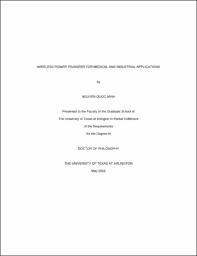
ATTENTION: The works hosted here are being migrated to a new repository that will consolidate resources, improve discoverability, and better show UTA's research impact on the global community. We will update authors as the migration progresses. Please see MavMatrix for more information.
Show simple item record
| dc.contributor.advisor | Chiao, Jung-Chih | |
| dc.creator | Nguyen, Minh Quoc | |
| dc.date.accessioned | 2018-02-01T15:31:36Z | |
| dc.date.available | 2018-02-01T15:31:36Z | |
| dc.date.created | 2016-05 | |
| dc.date.issued | 2016-05-10 | |
| dc.date.submitted | May 2016 | |
| dc.identifier.uri | http://hdl.handle.net/10106/27134 | |
| dc.description.abstract | My primary research focuses on wireless power transfer technology utilizing in two different areas: medical and industrial applications.
In the medical applications, my research focuses on design and optimization methods for spiral coils utilized for wireless power transfer in wireless medical implant applications. A theoretical model was examined for near field distributions of spiral-type transmitter antennas in both orthogonal components. Finite element simulations were performed to verify the theoretical radiation patterns. Receiver antenna voltages were measured at planes of interest as a means to map field distributions. Theoretical, simulation and experimental results were conducted in the free space and they agreed well. Understanding the orthogonal field components and their distributions in various distances between the worn transmitter coil outside the body and the receiver coil of implant that has a much smaller size provides a means to find the optimal location and angle to harvest maximum energy. The analysis method for near-field wireless power transmission can be utilized to determine design strategies of the transmitter spiral coil with also considerations in the amplifier circuit and physical constraints in practical scenarios to obtain maximum power and link efficiency for the implant devices. The method can be extended to investigate field distributions affected by human tissues, which construct a much more complex environment.
In the industrial applications, the effect of power combining and delivering in multi-input and multi-output (MIMO) wireless energy transmission systems which consist of more than one transmitter antennas as sources, more than one receiver antennas as loads and repeaters is investigated. Theoretical expressions were developed to model system operation that can be in a large scale wireless energy network architecture. System characteristics such as power transfer between antennas, power losses induced in each antenna, wireless efficiency, coil misalignment and power fluctuation due to the loss of frequency synchronization were examined by theory and verified with experiments. Measurement results matched well with the theory demonstrating the feasibility of combining and delivering power with high efficiencies in large scale wireless energy transmission systems | |
| dc.format.mimetype | application/pdf | |
| dc.language.iso | en_US | |
| dc.subject | Wireless power transfer | |
| dc.subject | Inductive coupling | |
| dc.subject | MIMO | |
| dc.subject | Frequency modes | |
| dc.title | Wireless Power Transfer for Medical and Industrial Applications | |
| dc.type | Thesis | |
| dc.degree.department | Electrical Engineering | |
| dc.degree.name | Doctor of Philosophy in Electrical Engineering | |
| dc.date.updated | 2018-02-01T15:33:43Z | |
| thesis.degree.department | Electrical Engineering | |
| thesis.degree.grantor | The University of Texas at Arlington | |
| thesis.degree.level | Doctoral | |
| thesis.degree.name | Doctor of Philosophy in Electrical Engineering | |
| dc.type.material | text | |
| local.embargo.terms | 2018-05-01 | |
| local.embargo.lift | 2018-05-01 | |
Files in this item
- Name:
- NGUYEN-DISSERTATION-2016.pdf
- Size:
- 2.433Mb
- Format:
- PDF
This item appears in the following Collection(s)
Show simple item record


